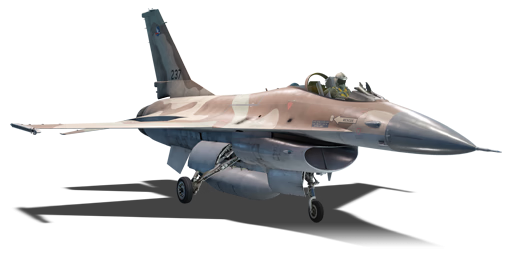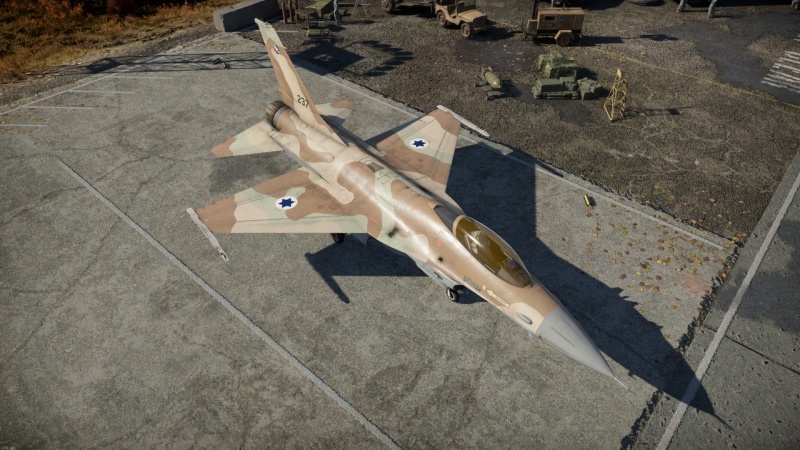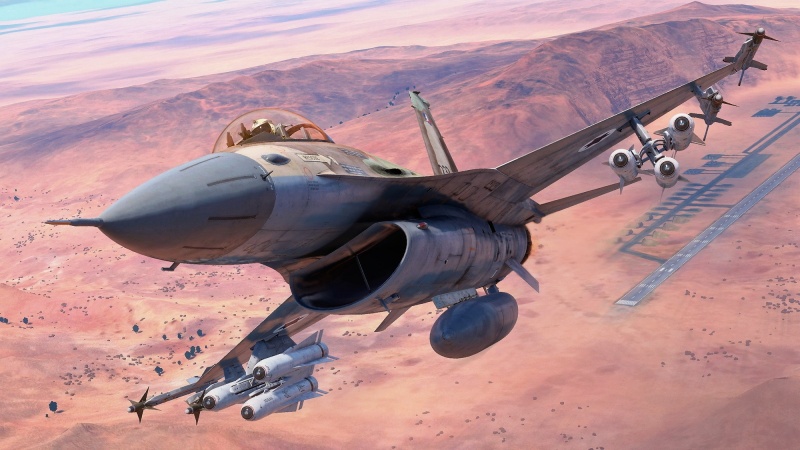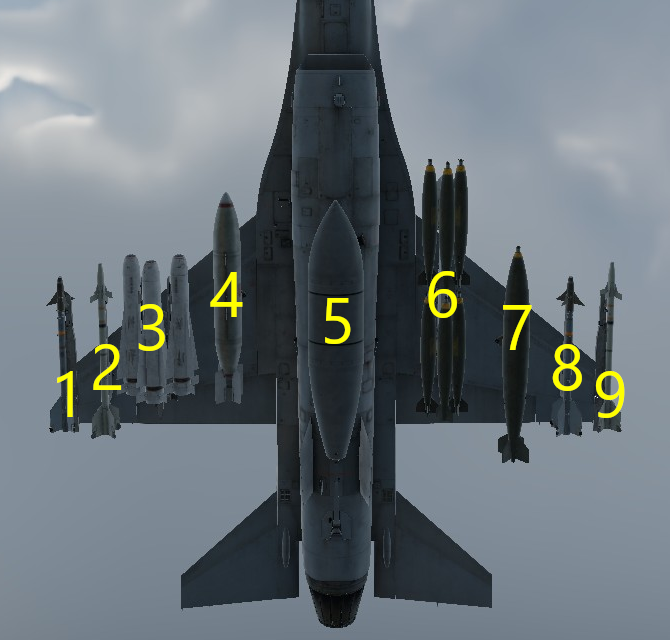Difference between revisions of "Netz"
Colok76286 (talk | contribs) (Removed About template) |
(→Suspended armament) |
||
| (2 intermediate revisions by 2 users not shown) | |||
| Line 14: | Line 14: | ||
{{Specs-Avia-Flight}} | {{Specs-Avia-Flight}} | ||
<!-- ''Describe how the aircraft behaves in the air. Speed, manoeuvrability, acceleration and allowable loads - these are the most important characteristics of the vehicle.'' --> | <!-- ''Describe how the aircraft behaves in the air. Speed, manoeuvrability, acceleration and allowable loads - these are the most important characteristics of the vehicle.'' --> | ||
| − | The F-16A Netz is very strong in a dogfight due to its excellent TWR and energy retention, its highly manoeuvrable and can easily reach its top speed even when climbing. | + | The F-16A Netz is very strong in a dogfight due to its excellent TWR and energy retention, its highly manoeuvrable and can easily reach its top speed even when climbing. |
{| class="wikitable" style="text-align:center" width="70%" | {| class="wikitable" style="text-align:center" width="70%" | ||
| Line 120: | Line 120: | ||
! colspan="5" | [[Ballistic Computer]] | ! colspan="5" | [[Ballistic Computer]] | ||
|- | |- | ||
| − | ! CCIP (Guns) !! CCIP (Rockets) !! CCIP (Bombs) !! CCRP (Bombs) !! | + | ! CCIP (Guns) !! CCIP (Rockets) !! CCIP (Bombs) !! CCRP (Bombs) !! EEGS |
|- | |- | ||
| {{Tick}} || {{Tick}} || {{Tick}} || {{Tick}} || {{Tick}} | | {{Tick}} || {{Tick}} || {{Tick}} || {{Tick}} || {{Tick}} | ||
| Line 132: | Line 132: | ||
The '''''{{PAGENAME}}''''' is armed with: | The '''''{{PAGENAME}}''''' is armed with: | ||
| − | + | * 1 x 20 mm M61A1 cannon, wing root-mounted (512 rpg) | |
| − | + | * 60 x countermeasures | |
| − | * | ||
=== Suspended armament === | === Suspended armament === | ||
| Line 145: | Line 144: | ||
|- | |- | ||
! !! width="5%" | 1 !! width="5%" | 2 !! width="5%" | 3 !! width="5%" | 4 !! width="5%" | 5 !! width="5%" | 6 !! width="5%" | 7 !! width="5%" | 8 !! width="5%" | 9 | ! !! width="5%" | 1 !! width="5%" | 2 !! width="5%" | 3 !! width="5%" | 4 !! width="5%" | 5 !! width="5%" | 6 !! width="5%" | 7 !! width="5%" | 8 !! width="5%" | 9 | ||
| − | | rowspan=" | + | | rowspan="13" width="30%" | <div class="ttx-image">[[File:Hardpoints_F-16A.png]]</div> |
|- | |- | ||
! [[LDGP Mk 82 (500 lb)|500 lb LDGP Mk 82]] bombs | ! [[LDGP Mk 82 (500 lb)|500 lb LDGP Mk 82]] bombs | ||
| Line 176: | Line 175: | ||
! 300 gal drop tanks | ! 300 gal drop tanks | ||
| || || || || 1 || || || || | | || || || || 1 || || || || | ||
| + | |- | ||
| + | ! 370 gal drop tanks | ||
| + | | || || || 1 || || 1 || || || | ||
|- | |- | ||
| colspan="10" | Maximum permissible weight imbalance: 2,000 kg | | colspan="10" | Maximum permissible weight imbalance: 2,000 kg | ||
| Line 184: | Line 186: | ||
{{Navigation-First-Simple-Line}} | {{Navigation-First-Simple-Line}} | ||
| − | * 1 x 300 gal drop tank | + | * 2 x 370 gal drop tanks + 1 x 300 gal drop tank |
| − | * 2 x AIM-9P Sidewinder missiles | + | * 2 x AIM-9P Sidewinder missiles + 2 x Python 3 missiles |
* 6 x AIM-9P Sidewinder missiles | * 6 x AIM-9P Sidewinder missiles | ||
* 6 x AIM-9L Sidewinder missiles | * 6 x AIM-9L Sidewinder missiles | ||
| Line 209: | Line 211: | ||
* Able to carry a drop tank to extend flight time | * Able to carry a drop tank to extend flight time | ||
* Has access to a wide range to air-to-ground loadouts | * Has access to a wide range to air-to-ground loadouts | ||
| − | * Access to 6 x AIM-9L Sidewinder or 6 x Python 3 missiles | + | * Access to 6 x AIM-9L Sidewinder or 6 x Python 3 missiles |
| − | * Python 3 missiles are very potent IR-guided missiles | + | * Python 3 missiles are very potent IR-guided missiles |
* Bubble canopy with excellent unobstructed 360° visibility gives great situational awareness in simulator mode | * Bubble canopy with excellent unobstructed 360° visibility gives great situational awareness in simulator mode | ||
| Line 217: | Line 219: | ||
* Consumes fuel quickly | * Consumes fuel quickly | ||
* No radar-guided AAMs | * No radar-guided AAMs | ||
| + | * The AGM 65 B does not have access to a thermal camera, which limits its use due to weather conditions | ||
== History == | == History == | ||
Revision as of 10:01, 31 August 2024
Contents
Description
The F-16A Block 10 Netz is a supersonic, 4th generation fighter aircraft, produced by General Dynamics. The F-16 was produced for the USAF as a part of the Lightweight Fighter Program, and notably the early blocks such as the Block 10 did not carry the AIM-7 Sparrow; this is carried over to the Netz in Israeli service. Israel is notably the second largest user of the F-16 after the USAF, and also achieved the first air to air kills with it.
It was introduced in Update "Apex Predators". Compared to the Block 15 and Block 20, the Netz is lighter and is able to pull an extra 1-2 Gs, making it one of the best dogfighters in the game. Compared to the Block 10 in the US tree it has a massive advantage, as it possesses the extremely potent Python 3, one of if not the most potent heat-seeking missiles in-game. In exchange it loses the GBU-8 "Hobo" for ground support. This leaves it as one of the best dogfighters in high tier battles, with reasonable multirole capability for CAS as well.
General info
Flight performance
The F-16A Netz is very strong in a dogfight due to its excellent TWR and energy retention, its highly manoeuvrable and can easily reach its top speed even when climbing.
| Characteristics | Max speed (km/h at 10,973 m) |
Max altitude (metres) |
Turn time (seconds) |
Rate of climb (metres/second) |
Take-off run (metres) | |||
|---|---|---|---|---|---|---|---|---|
| AB | RB | AB | RB | AB | RB | |||
| Stock | 2,103 | 2,037 | 15240 | 20.0 | 20.2 | 262.9 | 250.8 | 850 |
| Upgraded | ___ | 2,156 | __._ | 19.5 | __._ | 305.0 | ||
Details
| Features | |||||
|---|---|---|---|---|---|
| Combat flaps | Take-off flaps | Landing flaps | Air brakes | Arrestor gear | Drogue chute |
| X | ✓ | ✓ | ✓ | ✓ | X |
| Limits | ||||||
|---|---|---|---|---|---|---|
| Wings (km/h) | Gear (km/h) | Flaps (km/h) | Max Static G | |||
| Combat | Take-off | Landing | + | - | ||
| 1,555 | 482 | N/A | 470 | 463 | ~10 | ~3 |
| Optimal velocities (km/h) | |||
|---|---|---|---|
| Ailerons | Rudder | Elevators | Radiator |
| < ___ | < ___ | < ___ | N/A |
Engine performance
| Engine | Aircraft mass | |||||
|---|---|---|---|---|---|---|
| Engine name | Number | Basic mass | Wing loading (full fuel) | |||
| Pratt & Whitney F100-PW-220 | 1 | 7,690 kg | ___ kg/m2 | |||
| Engine characteristics | Mass with internal fuel (no weapons load) | Max Gross Weight | ||||
| Weight (each) | Type | 8m fuel | 20m fuel | 29m fuel | ||
| 1,470 kg | Afterburning low-bypass turbofan | 8,662 kg | 9,913 kg | 10,930 kg | 16,849 kg | |
| Maximum engine thrust @ 0 m (RB/SB) | Thrust to weight ratio @ 0 m (WEP) | |||||
| Condition | 100% | WEP | 8m fuel | 20m fuel | 29m fuel | MGW |
| Stationary | 6,490 kgf | 8,985 kgf | 1.04 | 0.90 | 0.82 | 0.53 |
| Optimal | 7,434 kgf (1,555 km/h) |
15,225 kgf (1,400 km/h) |
1.76 | 1.53 | 1.39 | 0.90 |
Survivability and armour
The F-16A Netz is not very armoured, so enemy aircraft can easily tear into your jet with some good timed shots. Its advised that you try to avoid being shot in the first place. The F-16A Netz has access to flares however so in the event of an enemy missile coming your way you'll be able to defend yourself, if not you can be lucky and survive some hits if the missile doesn't damage any vital components that are critical for your flight.
Modifications and economy
Armaments
| Ballistic Computer | ||||
|---|---|---|---|---|
| CCIP (Guns) | CCIP (Rockets) | CCIP (Bombs) | CCRP (Bombs) | EEGS |
| |
|
|
|
|
Offensive armament
The Netz is armed with:
- 1 x 20 mm M61A1 cannon, wing root-mounted (512 rpg)
- 60 x countermeasures
Suspended armament
The Netz can be outfitted with the following ordnance:
| 1 | 2 | 3 | 4 | 5 | 6 | 7 | 8 | 9 | ||
|---|---|---|---|---|---|---|---|---|---|---|
| 500 lb LDGP Mk 82 bombs | 3 | 3, 6 | 1 | 3, 6 | 3 | |||||
| 500 lb Mk 82 Snakeye bombs | 3 | 3, 6 | 1 | 3, 6 | 3 | |||||
| 2,000 lb LDGP Mk 84 bombs | 1 | 1 | 1 | 1 | ||||||
| BLU-27/B incendiary bombs | 1 | 1 | 1 | 1 | ||||||
| FFAR Mighty Mouse rockets | 57 | 57 | ||||||||
| AGM-65B missiles | 1, 3 | 1, 3 | ||||||||
| AIM-9P Sidewinder missiles | 1 | 1 | 1 | 1 | 1 | 1 | ||||
| AIM-9L Sidewinder missiles | 1 | 1 | 1 | 1 | 1 | 1 | ||||
| Python 3 missiles | 1 | 1 | 1 | 1 | 1 | 1 | ||||
| 300 gal drop tanks | 1 | |||||||||
| 370 gal drop tanks | 1 | 1 | ||||||||
| Maximum permissible weight imbalance: 2,000 kg | ||||||||||
| Default weapon presets | |
|---|---|
| |
Usage in battles
Describe the tactics of playing in the aircraft, the features of using aircraft in a team and advice on tactics. Refrain from creating a "guide" - do not impose a single point of view, but instead, give the reader food for thought. Examine the most dangerous enemies and give recommendations on fighting them. If necessary, note the specifics of the game in different modes (AB, RB, SB).
Pros and cons
Pros:
- High power-to-weight ratio gives it an incredible acceleration
- Highly manoeuvrable at lower speeds
- 20 mm Vulcan cannon has high velocity and rate of fire
- Able to carry a drop tank to extend flight time
- Has access to a wide range to air-to-ground loadouts
- Access to 6 x AIM-9L Sidewinder or 6 x Python 3 missiles
- Python 3 missiles are very potent IR-guided missiles
- Bubble canopy with excellent unobstructed 360° visibility gives great situational awareness in simulator mode
Cons:
- Consumes fuel quickly
- No radar-guided AAMs
- The AGM 65 B does not have access to a thermal camera, which limits its use due to weather conditions
History
By the end of the 1970s, Israel had established itself as the dominant air force in the Levant, having achieved technological superiority over the Soviet-equipped Syrian army - the only adjacent threat remaining after the signing of the peace deal with Egypt. This was mainly thanks to the purchase of F-15s into the Israeli Air Force (IAF) in 1976, which provided both a defensive and offensive umbrella that could not be challenged effectively by the Syrians. Nevertheless, the IAF still had two critical issues with the F-15: its prohibitive cost, and its relative unsuitability for low-altitude bombing, interdiction, and dogfighting. As the pressure mounted to replace the ageing F-4E Phantom II, Nesher and Kfir C.7, the IAF finally decided to purchase General Dynamics's new F-16 multi-role jet.
Israel received its first four F-16s on July 2nd, 1980 - a mix of F-16A and F-16B fighters (single-seat and two-seat, respectively) - with a total of 75 arriving by the end of 1981. These planes, mostly F-16As from production Block 10, were originally sold to Iran's Shah regime, a US ally since the 1950s; however in 1979 the Islamic Revolution deposed the Shah, marking a significant change in the balance of power in the region and solidifying Israel's status as one of the only remaining trustworthy US allies in the Middle East. Since the planes could no longer be delivered to Iran, they were instead sold to Israel.
The IAF named the model "Netz" (Hawk), making no distinction between the F-16A and B. Due to its amazing capabilities as a low-altitude fighter-bomber, the Netz effectively replaced all other IAF combat jets except for the F-15. By the late 1980s, the F-15 and F-16 together comprised nearly the entirety of the IAF's active combat jet force.
On April 28th, 1981, less than a year after its introduction into the IAF, Netz #126 codenamed "Magen" (Shield) made the world's first aerial kill by an F-16 when it shot down a Syrian Mi-8 over the Bekaa Valley in Syria. Only a few months after that, on June 7th, 1981, eight Netz F-16A/Bs comprised the attacking element in Operation Opera - the Israeli surprise attack on the Osirak nuclear facility near Baghdad, Iraq - in which the reactor was completely destroyed. All attacking fighters returned to base unharmed. The fact that Israel had concealed its preparations from the United States caused President Reagan to withhold the transfer of the final two dozen F-16s to Israel, but this decision was rescinded after only a short while.
One year later, on June 6th, 1982, Israel began "Operation Peace for the Galilee", later known as the First Lebanon War. A few days into the war, on June 9th through June 11th, Israel conducted "Operation Mole Cricket 19", a massive SEAD campaign that obliterated the entire Syrian air defense network along the Syrian border with Lebanon. Dozens of Netz F-16s participated in this attack as interceptors, fighting alongside F-15s to shoot down any Syrian jets scrambled against the wild weasels. By the end of the second day of this operation, Israel's Netz F-16s alone had shot down a total of 44 Syrian MiG-21s, MiG-23s and Su-22s - more than half the total number of enemy jets shot down during the battle - while suffering no losses in the process. This massive, one-sided air battle has become known as the "Bekaa Valley Turkey Shoot".
One Netz in particular - Netz #107 codenamed "Sufa" (Storm) - distinguished itself in world history by becoming the jet with the highest number of aerial kills to this day. This F-16A was the second to bomb the Osirak reactor in 1981, and later shot down a total of 6 enemy aircraft (plus one "kill assist"), most of them during the Bekaa Valley Turkey Shoot. Four of these kills were scored by Col. Eytan Stibbe during a single sortie on June 11th - the only F-16 pilot in the world to ever achieve this feat. Stibbe later became Israel's second-ever astronaut - the first Israeli to visit the International Space Station. Today, Netz #107 is on display at the Israeli Air Force Museum. Israel's advanced F-16I model line is named Sufa in honour of this plane.
Israel did at one point attempt to produce its own 4th-generation multi-role fighter to replace the F-16: the IAI Lavi. However pressure from the United States forced the project to be scuttled before production could begin. In compensation for torpedoing the project, the US agreed to provide Israel with 75 F-16C/Ds (codenamed "Barak" in Israel), which were delivered in 1987. Nevertheless, F-16A/Bs remained in IAF service for many years afterwards. In 1994, the United States compensated Israel for staying out of the First Iraq War by supplying it with another 50 surplus F-16A/Bs, most of them from the US National Guard and Air Force Reserves. Most F-16A/Bs in the IAF were eventually upgraded to F-16C/D standards. All Netz F-16A/Bs were retired from IAF service by around 2015.
Media
- Skins
See also
- Related development
External links
- https://forum.warthunder.com/index.php?/topic/558198-general-dynamics-f-16a-netz/
- https://www.af.mil/About-Us/Fact-Sheets/Display/Article/104505/f-16-fighting-falcon/
| General Dynamics Corporation | |
|---|---|
| Jet Fighters | F-16A · F-16A ADF · F-16C |
| Strike Aircraft | F-111A · F-111F |
| Export | ▄F-16A ADF · ▄F-16A · ▄F-16AM · ␗F-16A MLU · F-16AJ · Netz · F-16D Barak II · F-16C Barak II |
| F-111C | |
| See also | SABCA |
| Israel jet aircraft | |
|---|---|
| Kfir Canard · Kfir C.2 · Kfir C.7 · Nesher | |
| Britain | |
| Meteor | Meteor NF.13 · Meteor F.8 |
| France | |
| Vautour | Vautour IIA · Vautour IIN |
| Super Mystere | Sambad · Sa'ar |
| Mirage III | Shahak |
| Other | M.D.450B Ouragan · Mystere IVA |
| USA | |
| F-84 | F-84F |
| A-4 | A-4H · A-4E Early (M) · A-4E · Ayit |
| F-4 | Kurnass · Kurnass 2000 |
| F-15 | Baz · Baz Meshupar · F-15I Ra’am |
| F-16 | Netz · F-16C Barak II · F-16D Barak II |







